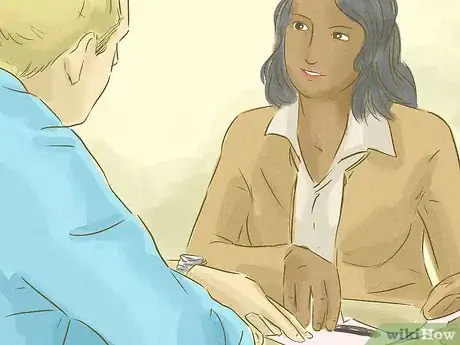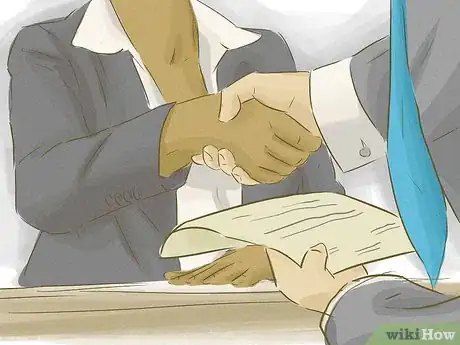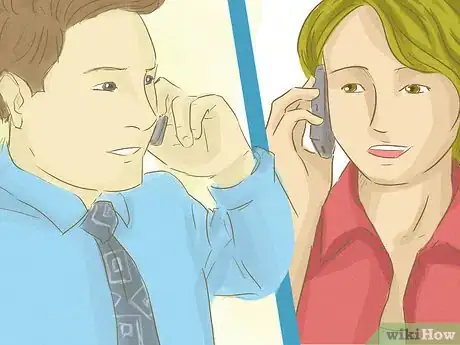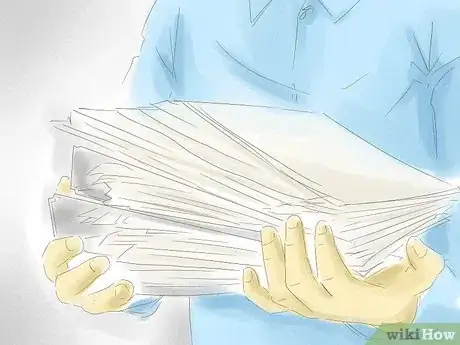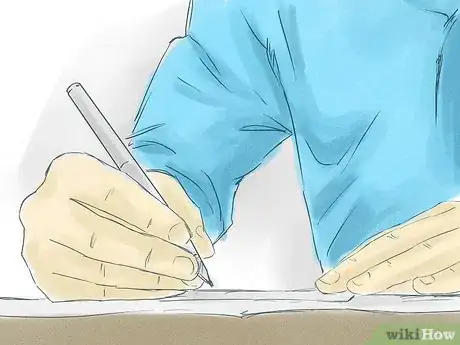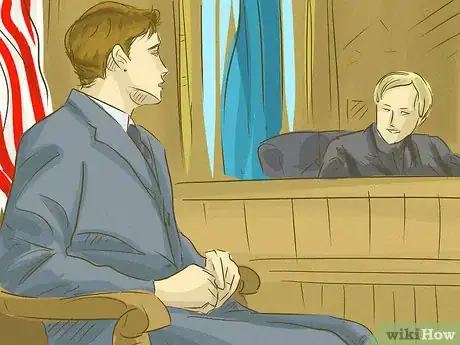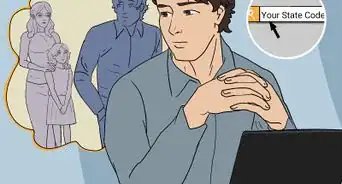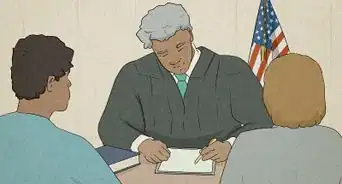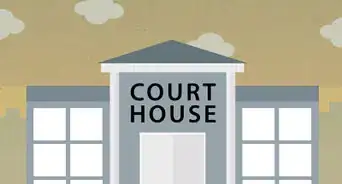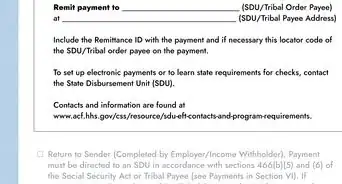This article was written by Jennifer Mueller, JD. Jennifer Mueller is an in-house legal expert at wikiHow. Jennifer reviews, fact-checks, and evaluates wikiHow's legal content to ensure thoroughness and accuracy. She received her JD from Indiana University Maurer School of Law in 2006.
This article has been viewed 46,070 times.
In some cases, despite the fact that your child is over the age of 18 or is no longer financially dependent on his parents, your child support will not automatically terminate – especially if the child support payments are being deducted from your paycheck. If you need to stop a child support order you may have to take steps yourself to have the order terminated. Typically you can do this either by contacting the child support enforcement agency and having the order terminated through administrative channels, or by filing a motion directly with the court that issued the original order.
Steps
Working with the Child Support Agency
-
1Read your original child support order. Your child support order may include specific dates or events when child support may be terminated.
- For example, some child support orders state that your child support obligation ends when the child reaches a certain age, such as 18. If your child is 18, then you have the right to terminate child support.[1]
- However, your child support order may not state clearly when it ends, which would leave it up to interpretation. If that's the case, you may want to talk to the other parent and see if you can reach an agreement that child support should end.[2]
-
2Contact your state's child support enforcement agency. Procedures may vary among states. If your case has been handled through your state's child support enforcement agency, an agency representative will be able to tell you what specific steps you need to take to stop your child support order.
- Unlike filing a motion or petition in court, there typically is no charge to have a child support order stopped using the child support enforcement agency.[3]
- You should contact the agency as soon as possible after you learn that you should no longer be paying child support. As long as the order is in effect, you are still on the hook for making payments – even if those payments are no longer necessary.[4]
- Usually both parents are responsible for notifying the agency if a change in circumstances requires the termination of child support. Although you can notify the agency initially over the phone, agencies typically require written notification along with copies of any documents that prove child support should be terminated.[5]
- Some states such as Missouri make the parent who receives the child support responsible for contacting the state agency when the payments should be terminated.
Advertisement -
3Gather information to support your claim. Before you fill out an application to have your child support order stopped, get copies of any documentation that would help prove your child no longer needs child support.
- For example, if your child support order states that your obligation ends when the child turns 18, you would want to attach a copy of the child's birth certificate and a copy of the original child support order.[6]
- If you want to stop your child support order because you have reconciled with the other parent, you would need to provide evidence that the two of you have actually reconciled.[7] For example, you might make copies of bills or other mail that shows you moved back to the same house.
-
4Fill out the application to terminate the support order. Each state agency has its own forms that you must complete and file with the agency before your child support order can be terminated.
- You must list the specific reason you believe your child support should be terminated, and provide documentation to back up that reason.[8]
-
5Cooperate with the agency's investigation. After you've submitted your application, the agency will review your application and evaluate the reasons you've stated your child support order should end.
- Most state agencies have a deadline for beginning and completing an investigation and notifying you of the results. For example, Ohio's Child Support Enforcement Agency must complete its investigation to verify the facts you set forth in your application within 20 days of receiving the information from you.[9]
-
6Receive notice of the agency's final decision. When the agency finishes reviewing your case, it will send you a notice of whether your child support has been terminated or will continue.
- Your notice typically will include an itemized listing of your account, including any back child support you still owe, any over-payments you've made, and any existing child support orders that remain for other children.[10]
- If the agency denies your request to terminate child support, your notice will include information on how to file a motion with the court or otherwise start an administrative or court hearing process on your case.[11]
Filing a Motion with the Court
-
1Read your original child support order. Before you file a motion with the court, review the terms of the initial order and look for any statements regarding the termination of your child support obligation.
- Your order may list specific events or dates that end your obligation under the order. If the date or event listed has occurred, that is all you need to prove to the court. For example, if your order states that your child support obligation ends on your child's 21st birthday, all you need to prove to the court is that your child recently turned 21.[12]
-
2Talk to the other parent. If you and the other parent are still on speaking terms, you may bring the issue up with the other parent and see if they agree with you that you should no longer be paying child support.
- If you can reach an agreement with the other parent, often you can file an agreed motion and have the judge approve it without having to attend a hearing.
- If both parents cannot agree that child support should be terminated, going to court and letting a judge decide may be your best option.[13]
-
3Get copies of the appropriate forms. Many courts have fill-in-the-blank motions you can use to ask the court to stop your child support order.[14]
- You should be able to pick up copies of the forms you need from the clerk's office, or download them from the court's website.[15]
- In some states such as Missouri, the parent who receives the child support payment is responsible for telling you when the child no longer meets the state's legal requirements to receive child support from you.
-
4Gather any required documentation. The court will need copies of the original order as well as any documents or other information that supports your claim that child support should end.
- If your child support obligation ends when your child reaches a certain age, all you need in addition to the original order is a document such as a birth certificate that proves the child's age.[16]
- If your original order provides for termination under certain conditions, you must be able to prove those conditions have occurred.[17] For example, suppose your order states that you owe child support until the child turns 18 unless the child attends college, in which case you must continue to provide support until the child turns 21. If your child is 19 but quit college and got a job, you would need proof that your child quit school and is living on his own.
- You also may no longer be required to pay child support if you got back together with the other parent. You would need to prove to the court that you've actually reconciled, for example by attaching evidence that you both live in the same house.[18]
-
5Fill out your forms. Enter the information required thoroughly and accurately, using the format requested by the court.
- In some states such as Missouri, you also must file an affidavit with the court listing the facts that indicate your child support obligation should be terminated. An affidavit is a sworn statement and typically must be signed in front of a notary public.
- If you and the other parent agree child support should be terminated, you both must sign the agreed motion and fill out the form for the agreed order, which the judge will sign.[19]
-
6File your forms with the appropriate court. You must file your motion with the same court that issued the initial child support order.
- Typically you must work directly with the court to stop your child support order if your order was not established through the state child support enforcement agency, or if the agency never took responsibility for administering your payments.[20]
- When you file your forms, you must pay a filing fee, usually under $100. If you cannot afford the filing fees, you can file an application with the court to have those fees waived. As part of that application, you will have to disclose various information about your financial status, income, and obligations.[21] #Have your forms served on the other parent. You will be responsible with providing the other parent with legal notice that you are asking the court to terminate your child support obligation.
- Typically you would contact the sheriff's department to have a deputy serve the forms on the other parent personally. Some courts may allow you to complete service using certified mail. You should expect to pay a small fee for service of process.[22]
- If you and the other parent came to an agreement, and you filed a joint petition or motion, you won't have to serve the other parent. In the court's eyes, both of you have filed the petition together.[23]
-
7Attend your hearing. If the judge schedules a hearing for your motion, you must appear or the judge may dismiss your motion and you will continue to owe child support.
- If you and the other parent agree that child support should be terminated, the judge typically will not order a hearing. He simply will sign the agreed order that you submitted to the court along with your agreed motion.[24]
References
- ↑ http://www.masslegalhelp.org/children-and-families/child-support/ending-child-support
- ↑ http://www.masslegalhelp.org/children-and-families/child-support/ending-child-support
- ↑ http://www.masslegalhelp.org/children-and-families/child-support/ending-child-support/how
- ↑ http://www.legalmatch.com/law-library/article/how-to-stop-child-support.html
- ↑ https://www.ohiobar.org/ForPublic/Resources/LawYouCanUse/Pages/LawYouCanUse-617.aspx
- ↑ http://www.masslegalhelp.org/children-and-families/child-support/ending-child-support
- ↑ http://www.masslegalhelp.org/children-and-families/child-support/ending-child-support
- ↑ http://www.legalmatch.com/law-library/article/how-to-stop-child-support.html
- ↑ https://www.ohiobar.org/ForPublic/Resources/LawYouCanUse/Pages/LawYouCanUse-617.aspx
- ↑ https://www.ohiobar.org/ForPublic/Resources/LawYouCanUse/Pages/LawYouCanUse-617.aspx
- ↑ https://www.ohiobar.org/ForPublic/Resources/LawYouCanUse/Pages/LawYouCanUse-617.aspx
- ↑ http://www.masslegalhelp.org/children-and-families/child-support/ending-child-support
- ↑ http://www.masslegalhelp.org/children-and-families/child-support/ending-child-support
- ↑ http://texaslawhelp.org/resource/termination-of-withholding-for-child-support
- ↑ http://www.masslegalhelp.org/children-and-families/child-support/ending-child-support/how
- ↑ http://www.masslegalhelp.org/children-and-families/child-support/ending-child-support
- ↑ http://www.masslegalhelp.org/children-and-families/child-support/ending-child-support
- ↑ http://www.masslegalhelp.org/children-and-families/child-support/ending-child-support
- ↑ http://texaslawhelp.org/resource/termination-of-withholding-for-child-support
- ↑ http://www.dfas.mil/garnishment/childsupportalimony/stoppayment.html
- ↑ http://www.masslegalhelp.org/children-and-families/child-support/ending-child-support/how
- ↑ http://www.masslegalhelp.org/children-and-families/child-support/ending-child-support/how
- ↑ http://www.masslegalhelp.org/children-and-families/child-support/ending-child-support/how
- ↑ http://texaslawhelp.org/resource/termination-of-withholding-for-child-support




